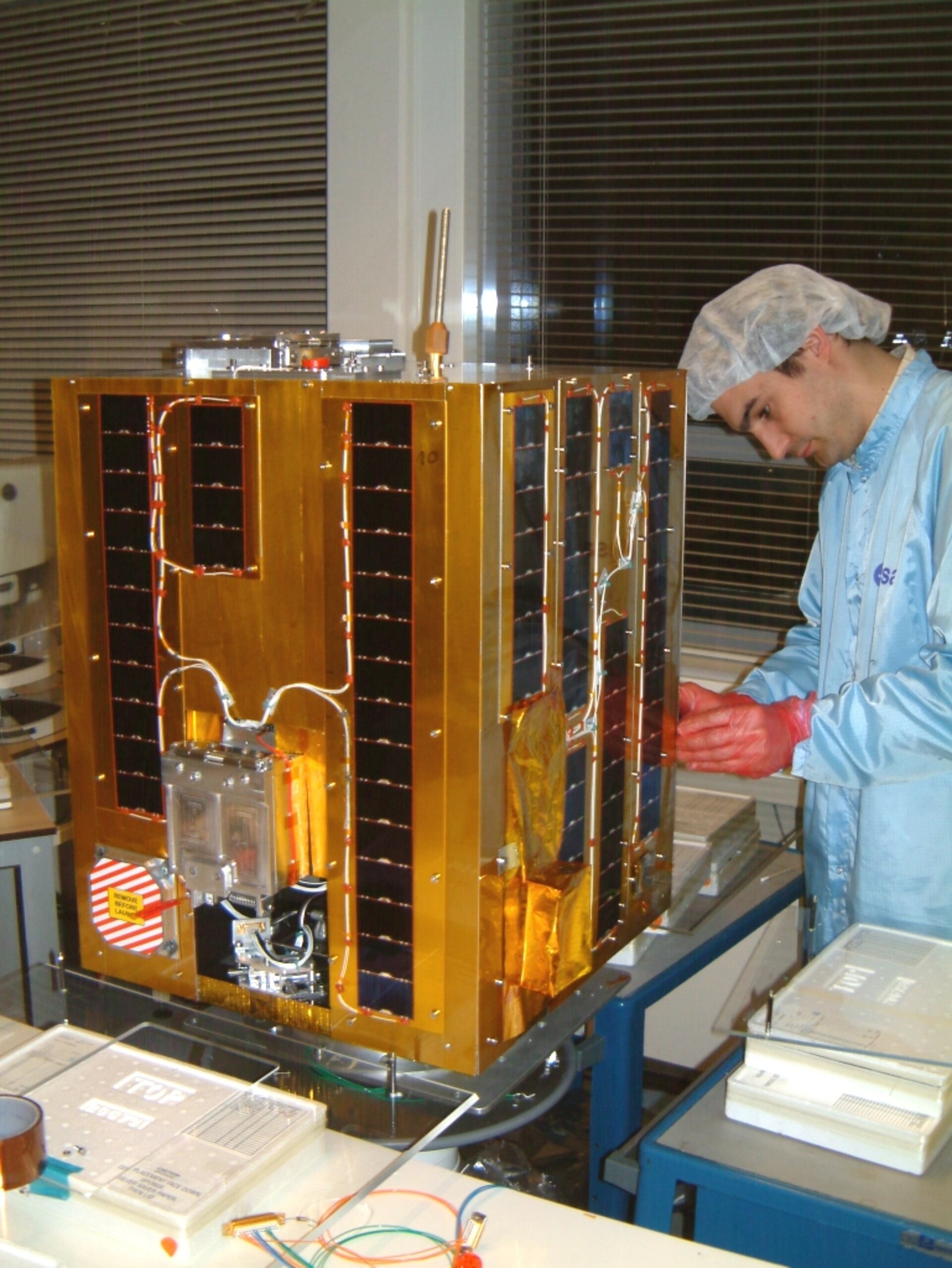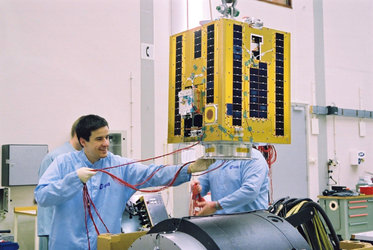First internet-built student satellite ready for launch
ESA PR 39-2005. SSETI Express, a low Earth orbit spacecraft designed and built by European university students under the supervision of ESA’s Education Department, is to be launched from the Plesetsk Cosmodrome on a Russian Cosmos 3M launcher on 27 September in the morning.
On that occasion, ESA will be organising a launch event at Space Expo, the public visitors’ centre close to ESA/ESTEC at Noordwijk in the Netherlands. A live televised transmission of the launch will bring images from Plesetsk and Space Expo to broadcasters and the general public across Europe. Specialists will be on hand for explanations and interviews, while schoolchildren will be invited to attend several activity workshops to express their views and enthusiasm for space.
The tentative programme for the day is as follows:
06:30 Guests and schoolchildren welcomed
07:00 Breakfast and general mission presentation
08:00 Children’s activities begin
08:15 Live transmission from Plesetsk
08:52 Lift-off
09:00 End of live transmission
Interviews and continuation of children’s activities
11:00 End of event
Some ESA centres will open their doors to media representatives for the launch of SSETI (see attached registration form). The ESA TV live broadcast will also be shown at several universities and research centres throughout Europe, where SSETI students will gather to follow the event (see Background Note for Editors).
Media representatives wishing to follow the event at Space Expo, or the rebroadcast transmission at the ESA establishments, are requested to fill in the attached registration form and to fax it back to the place of their choice.
For more information on SSETI Express please contact:
Philippe Willekens
Administrator for Education Projects
ESA Education Department
Tel: +33 1 53 69 73 88 (ESA-Paris) or +31 71 56 56 354 (ESA-ESTEC)
Mobile: +33 6 80 17 49 40
Fax: +33 1 53 69 76 01
Email:Philippe.Willekens@esa.int
For more information on the launch event at Space Expo please contact:
Rosita Suenson
ESA Communication Office at ESTEC
Tel: + 31 71 565 3009
Fax: + 31 71 565 5728
Email: Rosita.Suenson@esa.int

Background Note for Editors:
SSETI Express (SSETI stands for Student Space Exploration and Technology Initiative) is a small spacecraft, similar in size and shape to a washing machine (approx. 60x60x90 cm). Weighing about 62 kg, it has a payload of 24 kg. Onboard the student-built spacecraft will be three pico-satellites, extremely small satellites that weigh around 1 kg each. These will be deployed once SSETI Express is in orbit, marking a first not only for the students but also for the space sector. In addition to acting as a test bed for many designs, including a cold-gas attitude control system, SSETI Express will take pictures of the Earth and function as a radio transponder.
The SSETI Express satellite was designed and built mainly by students under the supervision of ESA’s Education Department. The principal sub-systems (power control unit, UHF unit for communications, onboard computer to control the satellite, attitude control system, propulsion system and camera) were developed at various European universities. The challenge has been for the 23 university groups, spread across Europe and from very different backgrounds, to work together via the internet to jointly build the satellite. ESA has provided support, drawing up the specifications, harmonising efforts, supervising construction and testing, and organising the launch.
ESA’s Test Centre at Noordwijk (the Netherlands) made its facilities and experts available to SSETI Express for thorough testing. The satellite underwent electromagnetic compatibility testing in a special chamber. SSETI Express was then mounted on a shaker table and subjected to vibration and shocks representative of those it will experience during launch. The harsh environment of space - vacuum, extreme thermal conditions, etc. - was simulated in one of the vacuum chambers at ESTEC.
System-level functional testing was also conducted at ESA’s technical centre, ESTEC. A ground segment simulator adjacent to the spacecraft was connected via a laptop computer and the internet to the mission control computer in Denmark. A further internet connection enabled the satellite operations team in Poland to control SSETI Express during testing, while communicating with staff at ESTEC via internet-based messaging.

SSETI Express has taken just 18 months to progress from kick-off to flight readiness review, which probably makes it the fastest spacecraft design and construction project ever, hence the name “Express”. By using donated materials, equipment and expertise - from ESA, universities and industry - total hardware expenditure by ESA’s Education Department has been kept below €100 000.
The Student Space Exploration and Technology Initiative (SSETI), which has provided the framework for the SSETI Express mission, was set up by ESA’s Education Department in 2000 to involve European students in real space missions. The initiative aims to give students practical experience and encourage them to work in the fields of space technology and science, thereby helping to prepare talented experts for the future.
Since its creation, SSETI has developed a network of students, educational institutions and organisations to facilitate work on various spacecraft projects. More than 400 European students have made an active, long-term contribution to this initiative, either as part of their degree or in their spare time. In addition, many hundreds more have been involved with or inspired by SSETI.
SSETI students are currently working on three main projects:
- SSETI Express
- SSETI ESEO, the European Student Earth Orbiter, a 120 kg spacecraft designed for Ariane 5 and scheduled for launch in 2008
SSETI ESMO, the European Student Moon Orbiter, scheduled for launch in 2010-12. It will conduct experiments both on its way to the Moon and once lunar orbit is achieved.
Follow the SSETI Express launch live
The ESA TV launch transmission on 27 September will be available as a free-to-air digital broadcast on the Astra 1 G satellite at 19.2 degrees East:
Transponder: 1.108
Reception frequency:12551.50 MHz (MCPC, ESA-Astra Multivision service)
Polarisation: Vertical
Symbolrate: 22 Msymb/s
FEC: 5/6
See also http://television.esa.int/photos/Astra.pdf
The launch can also be followed at these locations:
AIV -London -Cristina Rodriguez Trobajo - Cristina.Rodriguez-trobajo@imperial.ac.uk - Tel: +44(0)796.959.5340
AOCS +STRU - Faculdade de Engenharia da Universidade do Porto, Portugal, Antonio Melro (STRU) - antonio.melro@fe.up.pt Mobile : +351.93.386.2934 - Office : +351.22.508.21.64
COMM - Wroclaw, Poland - Dominik Guzda - El_dominico@o2.pl- Tel: +48.601.679.205
ESMO ADCS - Narvik, Norway - Antonsen Joran - ja@hin.no - Tel: +47.915.69.896
PROP - University of Stuttgart, Germany - Nils Harmsen - nils.harmsen@gmail.com - Tel: +49.163.795.2878
MECH - Euro Space Center - Jean-Marcel Thomas (Euro Space Center) - JF Vandenrijt (MECH team) - Jean-marcel.thomas@eurospacecenter.be - jfvandenrijt@ulg.ac.be - Tel: JF Vandenrijt +32(0)495.49.62.64
MIAS - Zaragoza, Spain - David Vicente - daviduve@yahoo.es - Tel: +34.610.87.34.95
TCS, HARN+ - UPC, Barcelona, Spain - Xavier Alabart Lopez - Xavier_alabart@yahoo.es - Tel: +34.610.625.702 - +34.93.405.40.12
OBDH+OPER - Warsaw, Poland - Pawel Kucharski - kuchar@desk.pl - Tel: +48.601.638.760
ADCS, CAM, OBC,MCC, GROU - Aalborg University,Denmark - Jens Frederik Dalsgaard Nielsen - jdn@control.aau.dk - Tel: +45.963.587.34 - +45.287.287.53
MAGIC - Lausanne, Switzerland - Martine Harmel - EPFL STI CST-GE ELD 013 (Bâtiment ELD), Station 11, CH-1015-Lausanne - martine.harmel@epfl.ch - Tel: +41.21.6936.948
Andoya Rocket Range - Marianne Moen, Norwegian Space Centre - Arne Hjalmar Hansen, Norwegian Centrer for Space-related Education - marianne.moen@spacecentre.no - Tel: +47.2251.1817 - arne.hjalmar@rocketrange.no - Tel: +47.9061.7264
For more information, please contact:
ESA Media Relations Division
Tel: + 33(0)1.53.69.7155
Fax: + 33(0)1.53.69.7690
Email: media@esa.int







